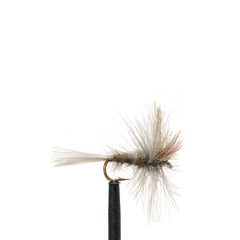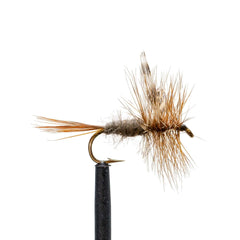The Majestic Mayfly

UNDERSTANDING THE MAYFLY LIFECYCLE
Mayflies go through several life stages, including the egg, nymph, dun, and spinner stages. Trout feed on mayflies in all stages of their life cycle, but the dun and spinner stages are the most important for fly fishing. During the dun stage, the mayfly emerges from the water and dries its wings before flying away. During the spinner stage, the mayfly lays its eggs on the surface of the water before dying.

TECHNIQUES FOR FISHING MAYFLIES:
When fishing with mayfly patterns, it is important to match the size and color of the fly to the natural mayflies present in the water, and to pay attention to the hatch timing and use the appropriate fly pattern during the hatch. It is also important to use a drag-free presentation, as mayflies have a delicate and natural drift on the water. One effective technique for imitating the natural movement of the mayfly is to cast upstream and let the fly drift downstream naturally, especially in faster-moving water. Alternatively, in slower-moving water such as pools and eddies, a dead drift technique with the fly in the water without any added movement can be particularly effective.
-
Match the Hatch: Mayflies come in different sizes and colors depending on their stage of development. Matching the hatch means choosing a fly pattern that mimics the size, shape, and color of the mayflies present in the water. This can increase your chances of catching fish that are actively feeding on mayflies.
-
Pay Attention to the Water: Mayflies hatch in different parts of the river or stream depending on the time of day and water temperature. Observing the water can help you locate feeding fish and determine the best time and place to fish.
-
Cast with Precision: Mayflies are delicate insects that float on the water's surface, making it important to cast your line accurately and gently to avoid spooking the fish. Try to present your fly upstream and allow it to drift naturally with the current.
- Use a Drag-free Drift: To achieve a natural-looking presentation, it's essential to avoid drag on your fly line. Drag occurs when the current pulls the line, causing the fly to move unnaturally. To avoid drag, try to mend your line upstream and allow it to drift naturally with the current.
RECOMMEND MAYFLY PATTERNS:
Here are some of the most popular mayfly imitations that you can use to catch trout during the spring season:-
 Dark Cahill
Dark Cahill
The Dark Cahill is a classic fly that imitates the Ephemerella subvaria mayfly, which is found throughout North America. It's a great fly to use in the early spring when the water is still cold and the mayfly hatches are just starting. This fly works well when fished in slow-moving water, such as eddies, and can be fished both dry and wet.
-
Light Cahill
The Light Cahill is a lighter version of the Dark Cahill and imitates the Stenacron interpunctatum mayfly. This fly is great to use in the late spring when the mayfly hatches are more abundant and the water is starting to warm up. This fly is best fished dry, and is particularly effective when fished in riffles or other fast-moving water.
Hendrickson
The Hendrickson fly is one of the most popular mayfly imitations, and for good reason. It imitates the Ephemerella subvaria mayfly in its dun stage, which is when the mayfly has just emerged from the water and is drying its wings before flying away. This fly works well when fished dry, and is particularly effective when fished in slower-moving water, such as pools or eddies.
-
Black Mayfly
The Black Mayfly imitates the Baetis tricaudatus mayfly, which is found in most parts of the world. This fly is best fished dry, and is particularly effective when fished in slow-moving water, such as pools or eddies. This fly is a great option to use in the late spring, when the mayfly hatches are more abundant.

-
Brown Mayfly
The Brown Mayfly is a great fly to use when fishing for trout in the late spring, when the water is starting to warm up and the mayfly hatches are more abundant. This fly imitates the Baetis mayfly, which is found throughout North America. This fly can be fished both wet and dry, and is particularly effective when fished in faster-moving water, such as riffles.
-
Cream Mayfly
The Cream Mayfly is a great fly to use when fishing for trout in the early spring, when the water is still cold and the mayfly hatches are just starting. This fly imitates the Ephemerella invaria mayfly, which is found throughout North America. This fly can be fished both wet and dry, and is particularly effective when fished in slower-moving water.
-
Olive Mayfly
The Olive Mayfly imitates the Baetis mayfly in its nymph stage, which is when the mayfly is still underwater. This fly is best fished wet, and is particularly effective when fished in slow-moving water, such as pools or eddies. This fly is a great option to use in the early spring, when the water is still cold and the mayfly hatches are just starting.
ADDITIONAL OPTIONS:

-
Adams
The Adams fly is one of the most popular dry flies and is a great all-around fly for imitating mayflies. This fly can be fished in a variety of sizes and colors to imitate different mayfly species. The Adams fly works best in faster-moving water, such as riffles and runs.
-
Blue Winged Olive (BWO)
The Blue Winged Olive is a small mayfly that is prevalent during the spring season. This fly can be fished in both the dun and nymph stages and is best fished in slower-moving water, such as pools and eddies. The BWO is an excellent choice for imitating emerging mayflies
-
Pale Morning Dun (PMD)
The Pale Morning Dun is a small mayfly that is prevalent during the late spring season. This fly can be fished in both the dun and nymph stages and is best fished in slower-moving water, such as pools and eddies. The PMD is an excellent choice for imitating emerging mayflies.
-
March Brown
The March Brown is a large mayfly that is prevalent in the early spring season. This fly can be fished in both the dun and nymph stages and is best fished in faster-moving water, such as riffles and runs. The March Brown is an excellent choice for imitating larger mayflies.
-
Sulphur
The Sulphur is a small mayfly that is prevalent during the late spring season. This fly can be fished in both the dun and nymph stages and is best fished in slower-moving water, such as pools and eddies. The Sulphur is an excellent choice for imitating emerging mayflies.
By keeping these techniques in mind, you can increase your chances of a successful fly fishing trip with mayflies. Remember to always practice ethical and sustainable fishing practices to preserve the ecosystem and ensure that future generations can enjoy the sport of fly fishing.
Happy Fishing & Tight Lines!







